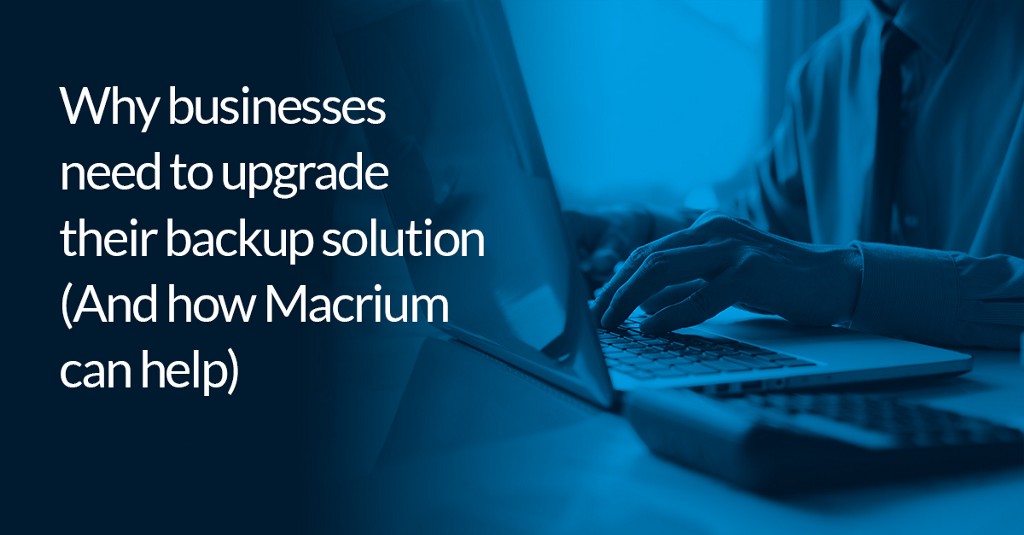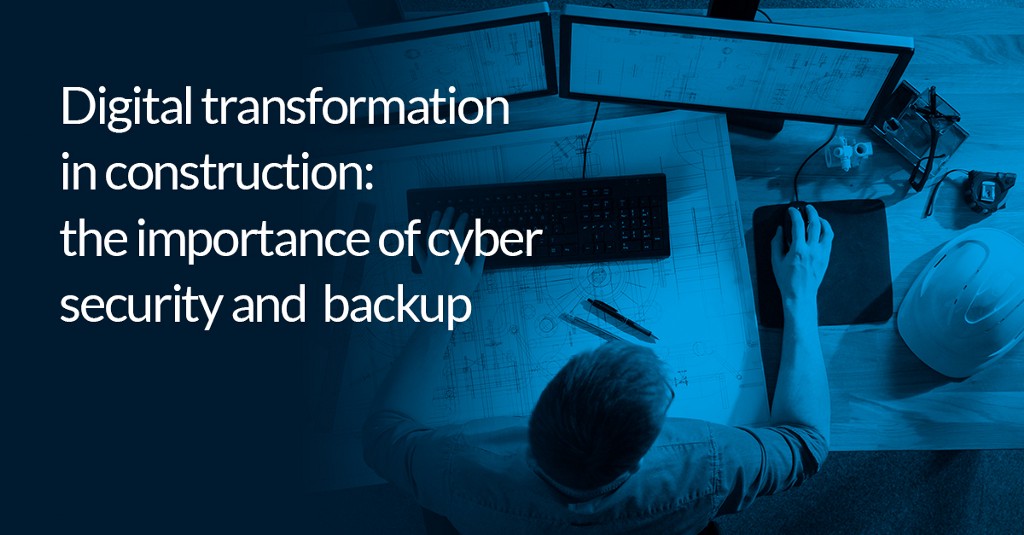Why businesses need to upgrade their backup solution (And how Macrium can help)

Backup isn’t the only part of a business’ cybersecurity or business continuity strategy, but it is undoubtedly a critical one. Indeed, the fact that backup software sits somewhere in between a number of domains — such as data protection and disaster recovery — highlights that it is an integral part of every organization’s IT asset portfolio.
Despite this, backup is often low on many business’ priorities. Research over the last 5 years underlines the fact that many organizations overlook backup software — one piece of research found that 32% of IT administrators believe that backing up was simply not a good use of their time. If those on the front line of IT feel they aren’t able to find time to backup their systems and data, it’s highly likely that those further removed from the day-to-day aspects of IT won’t be thinking about it too much either.
Of course, every organization has unique needs, from different IT infrastructure to different quantities and types of data. But as the world has evolved to become data-driven and our applications data-intensive, it’s difficult to see how anyone could claim backup is a waste of time. Protecting what matters is always important, as these uncertain times have demonstrated so painfully clearly.
But this isn’t to say that attitudes like those found in research should just be dismissed — they’re not personal failings, they’re symbolic of a wider culture that overlooks stability and resilience in favor of growth and speed. If the great pause caused by the coronavirus crisis has taught us anything, it’s not only that disasters can happen, but also that preparedness and planning can help to mitigate some of the issues and problems they cause.
Better backup is the foundation of a better way of doing business: one that is more resilient and prepared for unpredictability. Here are some of the reasons why backup is an essential part of a future where stability isn’t antithetical to growth, but instead a crucial part of it.
Explore Macrium’s range of backup products for businesses here.
Increasing IT complexity increases unpredictability
Ironically, the drive for efficiency in our systems and processes — and, by extension, simplicity — has led to increasing complexity when it comes to IT. This is one of the reasons that the CTO has become a vital role for even medium sized organizations — it requires judgement and strategic leadership to be done well.
But complexity may lead to unpredictability and vulnerability. With more moving parts inside even basic IT setups, there are new risks and points of failure. This means that backup is not only essential, but it also needs to be done in a multifaceted way. For example, while it’s tempting to simply see cloud backup as ‘good enough’ for your needs, on its own it only introduces a further element of complexity. In the event of an outage, for example, you’re placed in a precarious position.
This isn’t, of course, to dismiss cloud backup — instead it’s to highlight that effective backup requires a holistic mindset in which you are aiming to mitigate multiple risks from different sources.
Okay, maybe this sounds like another layer of IT complexity — and perhaps it is. But what it really illustrates is that good backup should be partnered with a strategic awareness of various points of weakness and vulnerability. Once you have understood and recognised these, it becomes much easier to properly add new dimensions to your infrastructure in a way that prioritizes security and resilience. This is much more effective than simply trying to plug up holes in a complex system (or, indeed, pretend they aren’t there).
How can Macrium help you manage IT complexity?
We’re not going to make any false promises — Macrium can’t simplify your IT setup. But what it can do is make managing backup much easier. This is true in a couple of different ways
In the first instance, let’s take the software market as it stands — in terms of both backup and in general. What we see is a saturated market with a huge range of options for different problems and different combinations of problems. What’s more, there are many feature heavy products attempting to integrate solutions in a way that drives up revenue and keeps its user base happy. At Macrium we’ve deliberately tried to avoid that — we focus on backup and backup alone: nothing more, nothing less. This means that when you purchase Macrium, you pay for what you get. It keeps things simple and cost effective for you.
Moreover, Macrium is designed to be easy to use. Given the statistic we discussed earlier — about a not insignificant minority of IT admins seeing backup as a poor use of their time — this is immensely valuable. When organizations use Macrium, they don’t need to be inside the product all the time — they can simply configure it however they want to use it and then let it do its job. We know IT staff have much more to worry about than backup, so we want the product to fit comfortably in their lives, not become the answer to everything.
Finally, because modern backup requires a multifaceted approach too, we know Macrium might well not be the only backup an organization decides to use. With a simple, straightforward product and clear, reasonable pricing, upgrading Macrium backup can complement your wider portfolio of IT assets, even those that are relatively similar.
The cost of downtime
In parallel with the increasing complexity of modern IT is the increasing importance of our IT systems for daily commercial and operational activities. This means the unpredictability that is part and parcel of software systems today costs more than ever.
There are plenty of studies that look closely at the cost of downtime. Of course, the matter is complex — and the cost of downtime will be unique to every single business. This post does a good job of explaining different ways of calculating downtime, but it also provides some neat stats that underline just how serious downtime can be.
While there are a number of tools that can help combat downtime, backup is critical insofar as it helps to ensure that data is easily available. In particular, backup that allows you to restore and reboot systems quickly is valuable for helping you to minimize downtime.
How can Macrium help minimize downtime?
There are a number of different features in Macrium Reflect that can help to minimize downtime. This includes viBoot, which allows you to launch Hyper-V virtual machines instantly, and Rapid Delta Restore and Clone, which can help you restore and clone data to another location in a fraction of the time it might typically take.
The growing threat of ransomware
Ransomware has been around for a while now, but attacks are steadily increasing. Research published at the end of March highlights the extent of its rise: it found that in 2019 62% of organizations were victims, growing from 56% in 2018 and 55% in 2017.
Interestingly, the report also found that 35.7% of respondents had been attacked by ransomware more than 6 times in 2019. This highlights that unlike other cybersecurity threats, ransomware isn’t a single devastating but unlikely event — it’s a continual threat that will continue to knock at the doors of just about every single business with a digital presence.
How can Macrium Reflect backup protect against ransomware threats?
The sharp point of ransomware that’s often missed by businesses and individuals is that backup files are just as vulnerable to attacks as any other. Back in February, the UK’s National Cyber Security Centre updated its guidance on ransomware protection to advise that files and data should be backed up offline, as this is one of the only ways to be sure that ransomware attacks can’t successfully encrypt them.
Well aware of the growing threat of ransomware, here at Macrium we’re incredibly proud of Macrium Image Guardian, a feature of Macrium Reflect which protects backup files from ransomware. Given the ubiquity of ransomware — and the fact that backup files are such an attractive proposition for attackers, backup without ransomware protection is as good as useless. You’re exposing yourself to serious trouble that you could easily eradicate with the right software.
The growing importance of data protection and privacy
GDPR was a big deal for many businesses when it came into force in May 2018. And although it still poses a challenge, by and large the legislation has done a lot of good in getting organizations to focus a lot more on users.
What often gets missed by many businesses are the compliance demands GDPR places on businesses in terms of security and data availability. This article does a good job of outlining the various implications that GDPR has in terms of backup and security, with the crucial takeaway being this: “GDPR requires… data to be available at all times to the subject.”
While GDPR compliance is critical in the here and now, we should also look towards the future. Legislation is likely only to grow, with businesses compelled to be more transparent in how they store and manage user data. When you partner this trend in policymaking with wider public awareness of privacy and digital security, the idea that backup and data protection simply isn’t worth staff time or effort will quickly become a relic of the past — public perception and hefty fines will likely transform the extent to which organizations prioritize data protection.
But how can Macrium help?
As an easy to use, reliable, and powerful backup tool, Macrium plays a small but vital role in ensuring that you are compliant with data protection regulations. Clearly the puzzle of data protection in the age of GDPR and public mistrust is complex and can’t be solved by a single product alone (if you think it can, you need to go back to the drawing board). But that doesn’t mean that a smart IT buying strategy can’t go a long way to ensuring you are complying with regulations while maintaining customer and stakeholder confidence.


